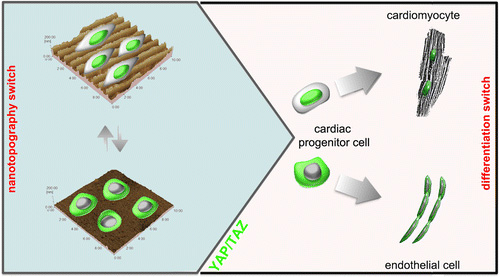- ホーム
- > 研究活動
- > Research Highlights
- > Vol. 12 Heart cells respond to stiff e・・・
 Research Highlights
Research Highlights
[Vol. 12]
Heart cells respond to stiff environments
Proteins associated with the regulation of organ size and shape have been found to respond to the mechanics of the microenvironment in ways that specifically affect the decision of adult cardiac stem cells to generate muscular or vascular cells.

Figure : Schematic illustrating how mechanical properties of substrates affect where YAP/TAZ protein localization in cardiac stem cells (left) and how this affects stem cell development and function (right).
Cell development for specific functions — so-called cell differentiation — is crucial for maintaining healthy tissue and organs. Two proteins in particular — the Yes-associated protein (YAP) and WW domain-containing transcription regulator protein 1 (WWTR1 or TAZ) — have been linked with control of cell differentiation in the tissues of the lymphatic, circulatory, intestinal and neural systems, as well as regulating embryonic stem cell renewal. An international collaboration of researchers has now identified that changes in the elasticity and nanotopography of the cellular environment of these proteins can affect how heart stem cells differentiate with implications for the onset of heart diseases.
Researchers at the International Center for Materials Nanoarchitectonics (MANA), National Institute for Materials Science (NIMS) collaborated with researchers in Finland, Italy, the Netherlands, Saudi Arabia and the Czech Republic in the study.
They engineered YAP and TAZ proteins that expressed green fluorescent protein so that their location within the cell could be tracked. They then prepared cell substrates from smart biomaterials displaying dynamic control of elasticity and nanostructure with temperature. “Our data provide the first evidence for YAP/TAZ shuttling activity between the nucleus and the cytoplasm being promptly activated in response to dynamic modifications in substrate stiffness or nanostructure,” explain the researchers.
Observations of gene expression highlighted the key role of YAP/TAZ proteins in cell differentiation. In further investigations on the effect of substrate stiffness they also found that cell differentiation was most efficient for substrates displaying stiffness similar to that found in the heart.
The authors suggest that understanding the effects of microenvironment nanostructure and mechanics on how these proteins affect cell differentiation could be used to aid processes that maintain a healthy heart. They conclude, “These proteins are indicated as potential targets to control cardiac progenitor cell fate by materials design.”
Reference
"Hippo pathway effectors control cardiac progenitor cell fate by acting as dynamic sensors of substrate mechanics and nanostructure"
Diogo Mosqueira, Stefania Pagliari, Koichiro Uto, Mitsuhiro Ebara, Sara Romanazzo, Carmen Escobedo-Lucea, Jun Nakanishi, Akiyoshi Taniguchi, Ornella Franzese, Paolo Di Nardo, Marie José Goumans, Enrico Traversa, Perpetua Pinto-do-Ó, Takao Aoyagi, and Giancarlo Forte
Journal : ACS NANO 8, 3, 2033–2047, (2014).
DOI : 10.1021/nn4058984
Diogo Mosqueira, Stefania Pagliari, Koichiro Uto, Mitsuhiro Ebara, Sara Romanazzo, Carmen Escobedo-Lucea, Jun Nakanishi, Akiyoshi Taniguchi, Ornella Franzese, Paolo Di Nardo, Marie José Goumans, Enrico Traversa, Perpetua Pinto-do-Ó, Takao Aoyagi, and Giancarlo Forte
Journal : ACS NANO 8, 3, 2033–2047, (2014).
DOI : 10.1021/nn4058984
Affiliations
International Center for Materials Nanoarchitectonics (WPI-MANA), National Institute for Materials Science (NIMS), Namiki 1-1, Tsukuba, Ibaraki 305-0044, Japan
Contact information
ナノアーキテクトニクス材料研究センター(MANA)
〒305-0044 茨城県つくば市並木1-1
TEL: 029-860-4710
E-mail: mana-pr=ml.nims.go.jp([ = ] → [ @ ] )
TEL: 029-860-4710
E-mail: mana-pr=ml.nims.go.jp([ = ] → [ @ ] )

